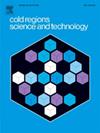Application of the improved twin-shear unified strength theory to the multiaxial strength of S2 columnar ice
IF 3.8
2区 工程技术
Q1 ENGINEERING, CIVIL
引用次数: 0
Abstract
An enhanced twin-shear unified strength theory is presented in this study, effectively decoupling the dual effects of intermediate principal stress on S2 columnar ice. By introducing two novel parameters, and , the improved model separately quantifies the weakening and strengthening contributions of to the multiaxial strength, thereby overcoming limitations in traditional formulations where these effects were coupled. The rate-dependent behavior and anisotropic responses under various loading directions are not only captured by the proposed model, but its descriptive scope of the intermediate principal stress inflection points is also extended from a linear to a surface-based representation. Biaxial and triaxial experimental data are systematically analyzed to validate the model, with results indicating a significant increase in both the strengthening and weakening effects as strain rates rise. Furthermore, the enhanced theory is integrated into a constitutive framework to compute the variable failure envelope of S2 columnar ice, which is subsequently implemented in Four-dimensional Lattice Spring Model (4D-LSM). Numerical simulations demonstrate that the modified envelope surface accurately reproduces experimental observations across diverse strain rate conditions and loading orientations. An orthotropic envelope surface design is also proposed to incorporate anisotropy induced by columnar jointing, thereby lending physical significance to the modification term. Moreover, the refined formulation bridges the gap between theoretical analysis and practical simulation, providing a robust framework for evaluating complex multiaxial stress states in anisotropic ice. Overall, comprehensive insights into the intermediate principal stress effects are provided in this study, and the characterization of S2 columnar ice is significantly improved.
改进双剪统一强度理论在S2柱状冰多轴强度研究中的应用
本文提出了一种增强的双剪切统一强度理论,有效地解耦了中间主应力对S2柱状冰的双重影响。通过引入两个新参数λ1和λ2,改进的模型分别量化了σ2对多轴强度的减弱和增强贡献,从而克服了传统模型中这些影响耦合的局限性。该模型不仅捕获了不同加载方向下的速率相关行为和各向异性响应,而且将中间主应力拐点的描述范围从线性扩展到基于曲面的表示。系统分析了双轴和三轴实验数据以验证模型,结果表明,随着应变速率的增加,强化和弱化效应都显著增加。此外,将改进后的理论整合到本构框架中,计算S2柱状冰的变破坏包络线,并在四维点阵弹簧模型(4D-LSM)中实现。数值模拟结果表明,改进后的包络面能较好地再现不同应变速率条件和加载方向下的实验结果。还提出了一种正交各向异性包络面设计,以考虑柱状节理引起的各向异性,从而使修正项具有物理意义。此外,改进的公式弥合了理论分析和实际模拟之间的差距,为评估各向异性冰中复杂的多轴应力状态提供了一个强大的框架。总的来说,本研究对中间主应力效应有了更全面的认识,并显著改善了S2柱状冰的表征。
本文章由计算机程序翻译,如有差异,请以英文原文为准。
求助全文
约1分钟内获得全文
求助全文
来源期刊

Cold Regions Science and Technology
工程技术-地球科学综合
CiteScore
7.40
自引率
12.20%
发文量
209
审稿时长
4.9 months
期刊介绍:
Cold Regions Science and Technology is an international journal dealing with the science and technical problems of cold environments in both the polar regions and more temperate locations. It includes fundamental aspects of cryospheric sciences which have applications for cold regions problems as well as engineering topics which relate to the cryosphere.
Emphasis is given to applied science with broad coverage of the physical and mechanical aspects of ice (including glaciers and sea ice), snow and snow avalanches, ice-water systems, ice-bonded soils and permafrost.
Relevant aspects of Earth science, materials science, offshore and river ice engineering are also of primary interest. These include icing of ships and structures as well as trafficability in cold environments. Technological advances for cold regions in research, development, and engineering practice are relevant to the journal. Theoretical papers must include a detailed discussion of the potential application of the theory to address cold regions problems. The journal serves a wide range of specialists, providing a medium for interdisciplinary communication and a convenient source of reference.
 求助内容:
求助内容: 应助结果提醒方式:
应助结果提醒方式:


